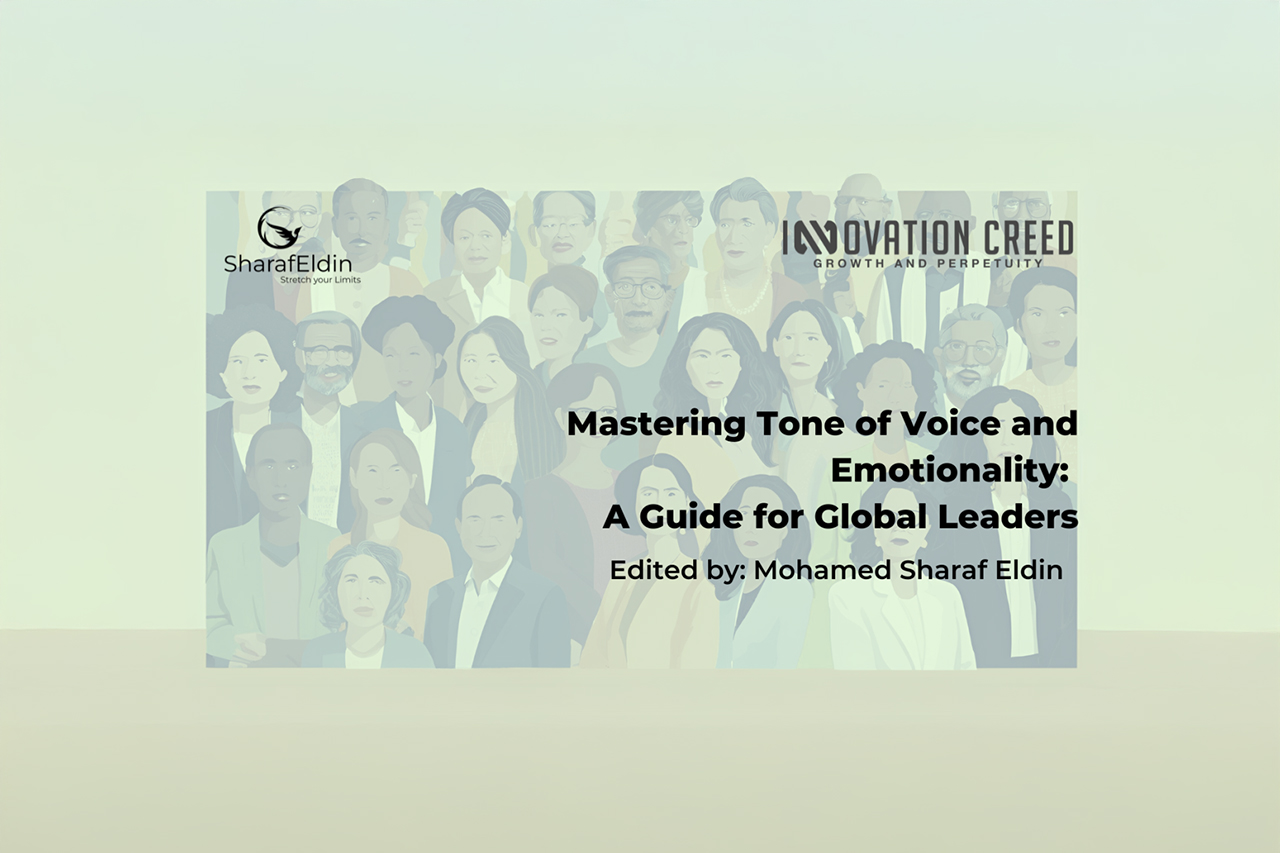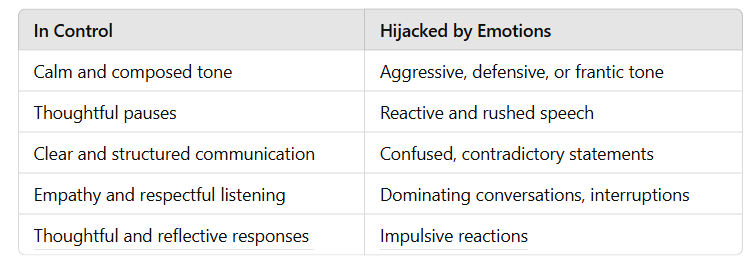
Effective leadership communication is more than just the words we say—it's deeply influenced by our tone of voice and emotional expressions. Especially for leaders managing multinational teams, mastering emotional intelligence and communication nuances can make a significant difference.
Healthy emotional communication in business is characterized by:
- Awareness & intentionality in emotional expression.
- Adaptability based on context, culture, and audience.
- Conveying authenticity without allowing emotions to overpower your message.
Signs of Emotional Control vs. Emotional Hijacking:

a. Enhance Emotional Awareness
- Label your emotions clearly: "I'm feeling frustrated because…"
- Regularly practice self-reflection: Identify triggers that cause emotional reactions.
- Develop mindfulness practices (breathing, meditation, journaling) to enhance your ability to notice emotions arising.
b. Practice Emotional Regulation Techniques
- Pause & breathe: Take a slow, deep breath before responding.
- Ground yourself: Notice your physical sensations (feet on the floor, posture, muscle tension).
- Self-check-ins: Periodically pause and ask yourself, “Am I emotionally balanced now?”
c. Leverage Emotional Intelligence (EI) Framework
Focus on EI’s four domains:
- Self-awareness: Recognize your emotional state.
- Self-management: Consciously regulate your emotions.
- Social awareness: Understand others’ feelings and perceptions.
- Relationship management: Communicate authentically and sensitively, adaptively managing emotional interactions.
a. Adjust Your Tone Strategically
- Direct but respectful in high-stakes discussions.
- Calm & warm when motivating or reassuring teams.
- Firm yet empathetic when addressing conflicts or difficult feedback.
- Expressive & visionary when inspiring or presenting new ideas.
b. Balance Emotionality with Professionalism
- Communicate emotion through deliberate language choices: "I appreciate your concern," rather than "I feel attacked." "This situation is challenging, but we will handle it," instead of "I’m frustrated."
- Maintain clarity and conciseness; focus on solutions rather than emotional venting.
c. Demonstrate Vulnerability Thoughtfully
Acknowledge challenges and share relevant personal experiences constructively:
- Effective: "I struggled with something similar before and found it helpful to…"
- Ineffective: Venting frustrations without providing constructive insights.
d. Active Listening & Reflective Responses
- Listen fully without immediate judgment or interruption.
- Summarize key points from others to demonstrate understanding: "What I’m hearing is…" , "Let me ensure I understood you correctly…"
a. Cultural Sensitivity & Adaptability
- Understand that emotional expression varies culturally: Some cultures prefer direct, assertive tones (e.g., North America, Western Europe), while others prefer indirect, restrained tones (e.g., East Asia, Middle East).
- Adjust your communication style based on audience preferences: More indirect in cultures sensitive to face-saving (Middle Eastern, Asian cultures). Direct yet empathetic in cultures valuing straightforwardness (Western European, North American contexts).
b. Avoid Stereotyping & Foster Inclusion
- Be mindful of individual differences rather than solely generalizing cultural behaviors.
- Clarify your intentions explicitly to avoid misinterpretations across diverse cultures.
c. Seek & Provide Clarification Proactively
- "Did my message resonate with you clearly?"
- "Help me understand your perspective better."
- Encourage feedback on your communication style to refine cross-cultural effectiveness.
a. Establish Emotional Boundaries
- Clearly define acceptable emotional behaviors within your team: Healthy expression encouraged, disrespectful or aggressive behaviors addressed promptly.
b. Model Emotional Maturity
- Demonstrate emotional control consistently, particularly during crises or pressure situations.
- Apologize authentically when your emotions negatively impact interactions.
c. Use Rituals to Strengthen Trust
- Regular check-ins, one-on-ones, and team meetings dedicated to open dialogue on emotions or team climate.
- Create safe spaces for team members to communicate their concerns or emotions honestly.
- Emotional journals: Track emotional triggers and reflections daily.
- Feedback loops: Regularly request feedback from trusted colleagues regarding your emotional tone and presence.
- Coaching or mentoring: Engage with professional coaches who focus on emotional intelligence, self-regulation, and cross-cultural communication.
- Attend EI workshops/trainings: Continuously develop your EI and communication skills through formal training.
- "I sense we’re facing some frustration; let’s clarify our next steps calmly."
- "Your concerns are important to me—let’s address them together."
- "I appreciate your perspective, though we may differ on how to move forward."
Effectively managing emotional tone and authenticity in business requires mindful self-awareness, deliberate emotional regulation, and adaptive cultural intelligence. Leaders who balance emotional authenticity and professional control cultivate trust, respect, and a healthier team environment, making them more influential and respected across diverse contexts.
Ready to explore your emotional expression in your leadership style together?